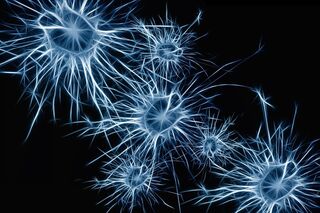Health
How Glial Cells Influence Your Mood
3 little-known brain cells may play a big role in your mental health.
Posted June 7, 2022 Reviewed by Abigail Fagan
Key points
- Microglia regulate brain immunity and may help explain the link between inflammation and depression.
- Astrocytes moderate signaling between neurons, including mood-related neurotransmitters.
- Oligodendrocytes create insulating covering over neurons but may also influence multiple aspects of neuron function related to mood.

Despite all our scientific advances over the last century, mood disorders like depression and anxiety remain incredibly common and difficult to treat effectively. Recent efforts to better understand the biology of these conditions have focused on the brain and the different types of brain cells involved. Currently, neurons get the lion’s share of the spotlight as it relates to both the biology of mental health conditions and their treatment. Yet growing evidence for the role of non-neuron brain cells in mood disorders is fueling novel opportunities for management and prevention.
Glial cells: beyond bystanders in brain health
Our brains are made up of billions of individual cells. The most well-known brain cell is the neuron, and when considering brain conditions like dementia, stroke or mood disorders, the neuron is front and center. There are over 80 billion neurons in the adult human brain. But there are an equal number of non-neuron cells called glial cells playing key roles in every aspect of our brain health.
Glial cells (named for the Greek word for “glue”) were first thought to represent connective tissue in the brain—basically just a support system for neurons. Over the decades it’s become clear that these cells perform a wide variety of key jobs in our brains ranging from facilitating neuron-to-neuron communication to affecting memory to immune regulation. With all these known functions, it’s no surprise that issues with glial cells are now thought to influence everything from dementia to post-stroke recovery, as well as being involved in various mood disorders.
One of the earliest connections between glial cells and mood comes from postmortem (after death) analyses of the brains of people with mood disorders. In a series of small studies, changes in the glial cell density and number were reported in brain areas like the anterior cingulate cortex, the prefrontal cortex and the amygdala—all regions implicated in mood regulation. Since then imaging, laboratory and cell studies have revealed a complex and fascinating role of glial cells in mood disorders.
Microglia: immune orchestraters of your brain
An incredible boundary called the blood-brain barrier (BBB) separates our brains from the rest of our bodies, keeping out most microbes and immune cells. But the existence of the BBB doesn’t mean the brain doesn’t participate in immunity. In fact, the brain has its own dedicated immune cells that patrol the brain for microbes, damage or other problems. These cells are called microglial cells, and they are understood to be vital to our brain health and increasingly, to our mood.
As regulators of the brain’s immune state, microglia are key to keeping brain inflammation in balance. Research has demonstrated a clear link between inflammation and depression, with higher levels of brain inflammation thought to contribute to depression. Elevated inflammation in the brain has also been linked to PTSD and schizophrenia. Like most of our body’s systems, microglial cells can be led to behave in ways that are good or bad for our health. So how could microglial cells get stuck promoting too much inflammation?
One of the most important tasks of microglial cells is surveillance. It’s thought that a vast network of microglial cells create a web-like network of hubs that constantly analyzes the brain for any evidence of immune threat. When these cells detect a problem, they switch into an activated form and start producing a variety of immune chemicals to help resolve the issue. While activated microglial cells can be helpful in neutralizing threats, chronic activation may contribute to unchecked inflammation in the brain and therefore depression.
It’s thought that microglial cells could become activated and contribute to depressive symptoms when the BBB breaks down and allows immune signals from the bloodstream to enter the brain. This could happen in cases of physical trauma, infection or stroke. But it’s also possible that microglial cells could become activated due to signals from an unhealthy gut, or from an excess of stress hormones. Finally, it’s worth noting that microglial cells also participate in the regulation of two other processes involved in depression, the wiring of and growth of new neurons (neuroplasticity and neurogenesis). Activated, inflammatory microglial cells are thought to have a negative impact on both of these processes, which could contribute to depression.
Astrocytes: key overseers of neuron health
Astrocytes have traditionally been considered neuron support cells, but they do a whole lot more than simple support. They get their name from their shape (they resemble stars). It’s thought that a single astrocyte may interact with millions of synapses. Astrocytes regulate neurotransmitters and connections between neurons, and they also make up a physical component of the BBB.
Our understanding of the role of astrocytes in brain health has greatly expanded since their discovery around 1900. In fact, a three-directional communication between neurons (where astrocytes oversee signals from both sides of the synapse) has been proposed, indicating that astrocytes play a vital role in regulating neuron health. It’s thought that astrocytes may play a key role in the creation of new synapses as well as regulation of neuroplasticity.
How do astrocytes broker the connections between neurons? One way is by picking up and releasing molecules like GABA (gamma-aminobutyric acid) and glutamate, neurotransmitters that play an essential role in brain signaling and mood. Some research also suggests that astrocytes can detect and absorb neurotransmitters like serotonin and norepinephrine which are considered among the most important molecules involved in conditions like anxiety and depression.
While research is still emerging, several studies have uncovered evidence for decreased astrocyte numbers and impaired function in people with depression. The reasons for these findings are under active study. However, the result of this may be that without functional astrocytes to help regulate communications between them, neurons are exposed to toxic levels of excitatory molecules like glutamate or insufficient levels of electrolytes like potassium that could damage neuron health.
Oligodendrocytes: more than just cover for neurons
Oligodendrocytes are the third group of glial cells found in the brain. Their best-established role in brain health relates to their production of myelin—the white covering that coats some neuron bodies and allows for quick signal transmission across the brain and spinal cord. Neurons with myelin are called “white matter,” while unmyelinated neurons are called “grey matter.” Further research on oligodendrocytes shows that they also influence brain energy, learning and memory.
A number of connections between oligodendrocyte health and depression have been made through imaging studies. For example, subjecting mice to social isolation (which has been associated with depression in humans) was linked to changes in oligodendrocyte structure and function. These changes correlated with impairments in with neuron myelination in the prefrontal cortex, a key region of the brain implicated in depression.
Like other glial cells, oligodendrocytes have receptors for neurotransmitters (like serotonin and dopamine), stress hormones and immune signals. This means they’re sensitive to environmental influences. And as oligodendrocytes are capable of producing pro or anti-inflammatory signals, it’s highly likely that these cells are actively participating in the moment-to-moment health of neuron and our mental health beyond contributing to myelination.
What comes next
Mental health remains one of the biggest challenges faced by the world today. Conventional therapeutics, even when available, fail to benefit up to one-third of treated patients. Yet the growing understanding of depression neurobiology opens the door to a more nuanced use of existing treatments, leveraging targeted lifestyle interventions and knowledge of potential preventive strategies. Though neurons remain at the forefront of depression conversations, existing and ongoing research on glial cells is likely to expand the vanguard of how we discuss and approach a wide range of mental illnesses.




